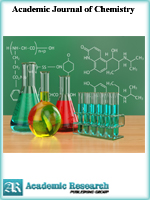Academic Journal of Chemistry
Online ISSN: 2519-7045
Print ISSN: 2521-0211
Print ISSN: 2521-0211
Quarterly Published (4 Issues Per Year)

Archives
Volume 4 Number 7 July 2019
Non Destructive Methods (XRF and XRD) For Estimation of Impure Carbon and Heavy Metals in Printer Toner Ink Powder
Authors: Adams Udoji Itodo ; Sumi Roselyn Benjamin ; S. Ande
Pages: 40-49
DOI: doi.org/10.32861/ajc.47.40.49
Abstract
Air pollution constitutes the largest among all of the environmental risks. Dust and soot fragments forms components of air particulates, which are released into the air as extremely small particles or liquid droplets. The basis of this research is to characterize toner ink powder and wood soot samples and the detection of metallic pollutants in wood soot (WS) and printer toner ink (PIS) for their physicochemical properties (pH, conductivity, bulk density and moisture content) and instrumental analysis using scanning electron microscopy (SEM) and Fourier Transform Infrared (FTIR). Two non- destructive analytical techniques; Dispersive X-ray Fluorescence Spectrometry (ED-XRF) and X-ray Diffraction (XRD) were adopted for heavy metals (elemental) composition and mineralogy respectively. The pH of printer ink and wood soot shows higher pH value which indicates that they are alkaline. Low conductivity values were reported with low moisture, indicating easy fragmentation and spreading. The bulk density values for samples shows that the soot can be easily spread by air current to the environment. The EDS analysis indicates that the soot particles to be composed of primarily impure carbon, thus pointing at potential organic pollutants. The IR spectra show characteristics signals at 749.2 cm-1, 745.5 cm-1, 738.0 cm-1 and 745.5 cm-1 for wood soot and printer ink which correspond to C-H of aromatic group, 1703.4 cm-1, 1699.7 cm-1. The XRF analysis reveals high concentration of Chromium and other toxic metals. The mineralogical components of the soot and printer ink samples revealed the presence of associated minerals. Generally, levels of toxic metal exceed the permissible legislative limit for air samples.
Chemical Modification of Expandable Graphite by Boric Acid and Its Flame Retarded Application in Polyethylene
Authors: Ya-Fang Meng ; Xiu-Yan Pang ; Wei-Shu Chang
Pages: 34-39
DOI: doi.org/10.32861/ajc.47.34.39
Abstract
The aim of this research is to get the graphite intercalation compound with high thermal stability and fire resistance. Firstly, the normal expandable graphite (EG) was prepared with potassium permanganate (KMnO4) as oxidant and sulfuric acid (H2SO4) as intercalator, respectively. Then, with (3-Aminopropyl)-trimethoxysilane (KH-550) as coupling agent, the boric acid (H3BO3) modified EG (EGB) was prepared by silane grafting method through H3BO3 bonded with EG. The analysis of X-ray powder diffractiometer and Fourier transform infrared spectroscopy testified the existence of EGB. EGB showed better thermal stability and flame retardancy for linear low density polyethylene (LLDPE) than the referenced EG. Addition of 13.0 wt% of EGB improved the limiting oxygen index (LOI) of 87.0LLDPE/13.0EGB to 24.6%, which was obviously higher than that of pure matrix of 17.5%. Whereas, the LOI of 87.0LLDPE/13EG was 22.7%. Furthermore, when EGB combined with ammonium polyphosphate (APP), the LOI and UL-94 level of 87.0LLDPE/8.7EGB/4.3APP reached 27.1% and V-0, respectively.



